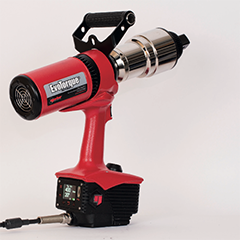What is torqueing and why is it important to be able to record it? PES finds out from Norbar, the torque tool specialists.
In this context, torqueing is principally the measured application of rotational force to a threaded fastener. When the torque is either under or over the manufacturer’s specification, it can cause considerable damage to the turbine structure. Protecting against this risk should be of primary importance so the health and safety of operatives and the life expectancy of the turbine are safeguarded.
The extent of the damage from inaccurately applied torque can vary substantially. The potential for vibrations occurring in the turbine is perhaps the most crucial technical implication of over or under torque. Any vibration presents a real risk of calamitous failure.
Maintenance operatives across many windfarms need to use an assortment of tools to finish the job. In the turbine tower for example, an operative may need one tool to run down the bolts plus a hydraulic wrench to achieve final torque. Using these two tools present a number of potential complications, particularly regarding ease of operation and manoeuvrability. Subsequently health and safety is a significant concern. Therefore having the ability to record the torque data from tightened joints for audit purposes would be a distinct benefit.
Furthermore, when triggering electric multipliers on pre-tightened bolts, a dangerous over-torque can occur due to the slow response time of controllers, high motor start currents and high motor inertias. In some instances, this over-torque can be in the region of 100 percent. When triggered multiple times in this type of condition, there is an extreme danger that the application may fail due to the overstress of the joint.






























